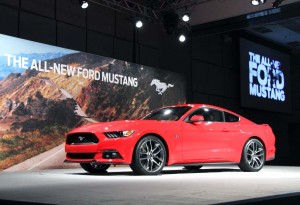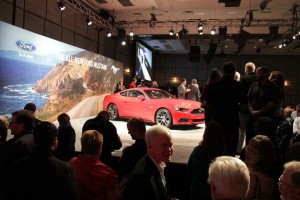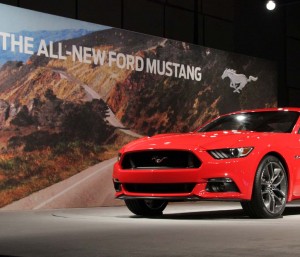She was just 22 years old, a fresh graduate from a teacher’s college and excited about life, so when Gail Wise went to the Ford showroom near her family’s home in suburban Chicago, she told the salesman she wanted something new, youthful and special.
He wasn’t supposed to show her the car tucked in the back of the showroom under the tarp. The official introduction wasn’t for two more days, but for some reason, he lifted the covers and then sold the powder blue 1964-1/2 Ford Mustang to the entranced young woman.
It was the same Mustang that Wise, now retired, proudly showed off during the ceremonies marking the debut of an all-new, sixth-generation pony car designed to mark the 50th anniversary of the Mustang’s launch.
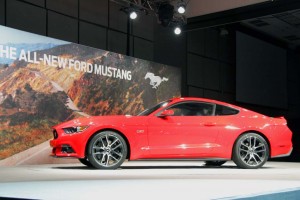
The new Mustang follows the classsic form but there are numerous subtle changes to the design - and major ones under the skin.
Asked by Ford Chief Operating Officer Mark Fields whether she’d be more willing to trade in the 50-year-old Mustang or her husband of 47 years, Wise hesitated then admitted, “It’s a hard choice.”
Ford is hoping the new Mustang will be a much easier choice for buyers not only in the U.S., but also around the world. The completely redesigned 2015 model will be the first that the maker will attempt to turn into a world car, with plans to introduce it into Europe and Asia following its North American launch. Considering the fact that there are fan clubs from Sweden to Shanghai, it could generate 10% or more of the new Mustang’s sales.
The roll out of the new Mustang came as a bit of a surprise to some observers who originally expected Ford to wait until next Spring with a debut in the Big Apple to mark the 50th anniversary of the original Mustang’s April 13, 1964, introduction at the Ford Pavilion at the New York World’s Fair.
The original car was a shock to American car buyers used to the big, stodgy machines of that era. It was spry and youthful and appealed to a Baby Boom generation just beginning to get behind the wheel, looking for cars that reflected their more sporty attitude about life.
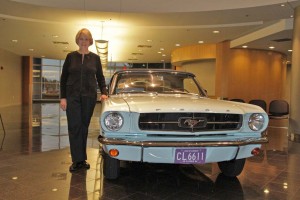
Gail Wise, a retired school teacher, stands with her 1964 1/2 Ford Mustang, that was part of the ceremonies introducing the 2015 Ford Mustang.
Over the decades, Ford has repeatedly tried to repeat that formula, not always successfully – as it realized immediately after the debut of the disastrous Mustang II model. And that clearly weighed on everyone as Ford set out to develop not only a new Mustang but also one that would celebrate the fact that the pony car is one of the few nameplates on the road to have continued without interruption for more than half a century.
(To check out the Mustangs that never were, Click Here.)
“Whenever you work on an icon it’s both a tremendous honor but also the source of a lot of angst,” said Ford COO Fields, adding that the most common phrase heard around the design studio during early development of the 2015 model was, “Not good enough.”
Whether the new Mustang is, indeed, good enough remains to be seen. But it certainly makes a good first impression, according to many in the standing-room-only crowd on hand for its debut.
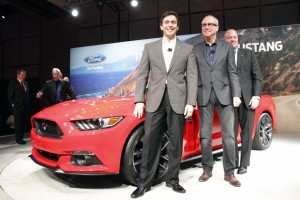
Ford COO Mark Fields and outgoing design chief, J Mays, introduced the new 2015 Ford Mustang, engineering chief Frank Davis is in back.
The 2015 Ford Mustang maintains the basic looks of the classic, borrowing more than a few of its cues from the original unveiled by then-Ford President Lee Iacocca a half century ago. There’s the long nose, the wide and powerful haunches and the short rear deck.
But even some traditional details, such as the classic three-bar taillights and racing Mustang emblem have been updated. The nose is now graced by three angled LED running lamps. The hood and side panels are more sculpted. The windshield is more steeply raked, a move meant to improve aerodynamics. In fact, a number of subtle tweaks and added details, such as new underbody panels, have been made to improve fuel-saving and performance-enhancing aerodynamics.
(Click Here to see TDB’s First Look at the 2015 Ford Mustang.)
Despite looking a lot like Mustangs of yore, the 2015 Ford performance coupe rides on an all-new rear-wheel-drive platform. While Frank Davis, the project’s engineering chief, wouldn’t discuss details, it has been widely speculated that a version of the new “architecture” will soon be shared with a sporty coupe to come for the struggling Lincoln brand.
What Davis did note is that the 2015 Mustang is a fraction of an inch shorter than the outgoing pony car, 1.6 inches wider and 1.5 inches lower than the 2013 ‘Stang.

Ford COO Mark Fields showed off his Mustang cufflinks during the introduction of the 2015 Mustang today.
There were a number of critical changes made to minimize mass – though Ford has not yet revealed the new car’s weight. It uses a new aluminum hood and fenders, as well as aluminum suspension components. That should help compensate for the added weight of adopting a new independent rear suspension – a must these days for any vehicle claiming performance credibility. The only Mustang ever to offer an IRS in the past was the limited-run SVT Cobra built between 1999 and 2004.
(For more on this week’s 2015 Ford Mustang debut, Click Here.)
Among the other major changes – addition, in this case – is the introduction of a third engine option, a 2.3-liter inline-four EcoBoost, the latest member of that new turbocharged powertrain family. Designed to deliver both fuel economy and performance, it could give a boost to demand abroad, especially in markets like Europe where performance fans still have to cope with fuel costs of as much as $9 a gallon.
That new engine, developing an estimated 305 horsepower and 300 pound-feet of torque, could also appeal to Americans who want performance and fuel economy from the same vehicle.
Ford isn’t walking away from its classic 5.0-liter V-8, and by adopting updates such as a new valve train and cylinder heads, the new Mustang GT will churn out a hefty 420 horsepower and 390 lb-ft. And the “base” Mustang won’t be a stone pony, the 3.7-liter V-6 rated at 300 hp and 270 lb-ft of torque. In fact, those would have been impressive numbers for a Mustang GT not that many years back.
A critical goal, according to engineering chief Davis, was “establishing Mustang as a world-class vehicle for ride and handling,” so even the brakes were upgraded, with optional new Brembos available in the new performance series.
But there is also a range of new high-tech features: radar-guided active cruise control, blind spot warning, cross traffic alert, a large touchscreen for the Sync infotainment system – and a push-button starter – among them. Also new: selectable drive mode and, across the board, new Launch Control, a feature first added on the limited edition 2013 Shelby GT500.
Ford isn’t saying how big its aspirations are for the new Mustang, though COO Fields did admit it doesn’t expect to sell near the 417,000 moved during the pony car’s first year on the market. That success earned the original team a special pair of “floating Mustang” cuff links, a set of which a retired exec gave Fields to wear during the new Mustang unveiling.
Other details yet to be revealed include pricing, though Ford is expected to start the base model at around $25,000 when it goes on sale next autumn. The European launch will follow during the first half of 2015, the Asian debut six months later.
Retired teacher Wise wasn’t the only long-time Mustang owner on hand for the Thursday unveiling. Also watching the debut was Edsel Ford, great-grandson of the automaker’s founder and son of former Chairman Henry Ford II. He got his own Mustang for Christmas after turning 16 in 1966 and took it for a drive in the snow that evening.
“I made sure not to wreck it,” he recalls, adding that he made the mistake of selling his first Mustang.
Gail Wise almost did the same thing, letting it nearly rust into the ground for 27 years. It’s now been fully restored, its chrome and paint more than a match for the all-new 2015 Mustang it sat alongside.

